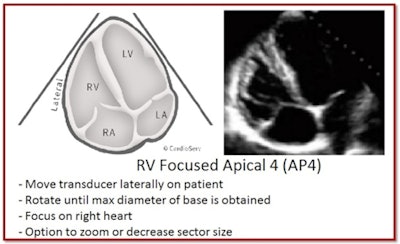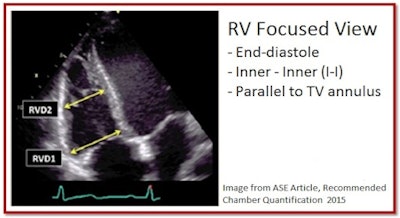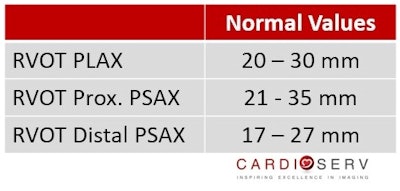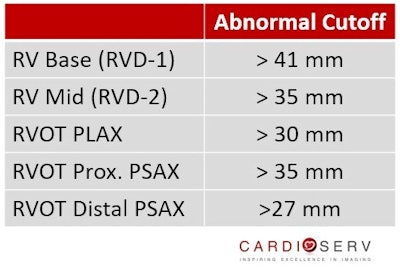
The right heart has jokingly been referred to as the organ's stepchild, with little attention paid to its size, function, and prognostic implications. To help with this often overlooked task, our new article series will review the proper methods to quantify the right heart for both size and function.
Part 1 of our series on right heart quantification awareness reviewed the basic anatomy of the right heart and outlined the American Society of Echocardiography's (ASE) updated recommendations for quantifying right heart size and function. This article will discuss proper measurements for evaluating the size of the right ventricle (RV).
Imaging window
The ASE suggests measuring the right ventricle size in the RV-focused apical 4 (AP4) view. Remember, the right ventricle is a crescent-shaped structure that hugs the left ventricle, which is why as many views as possible must be obtained to fully examine the size and structure. The RV-focused AP4 view is the specific view that allows for fully visualizing the maximum diameter of the RV.
 All images courtesy of CardioServ.
All images courtesy of CardioServ.Measuring RV size
Although right ventricle size can be measured either with linear measurements or volumetric measurements, the ASE recommends using linear measurements due to the lack of advanced education in laboratories for performing volumetric measurements. In addition, a wealth of published data has documented dimension references and the reproducibility of this method.
Linear measurements of the right ventricle's size are performed in the RV-focused AP4 view as follows:
- End-diastole at the widest width
- Parallel to tricuspid valve annulus
- Inner edge to inner edge (I-I)
- RV base (RVD-1): Basal 1/3 of RV
- RV mid (RVD-2): Middle 1/3 of RV at level of papillary muscles


Measuring RV outflow
All right ventricular outflow tract (RVOT) measurements are performed in the parasternal window using the inner edge to inner edge method at end-diastole. The proximal RVOT can be measured in both the long- and short-axis parasternal windows:
- Parasternal long axis (PLAX): Anterior RV wall to interventricular septum
- Parasternal short axis (PSAX): Anterior RV wall to aortic valve
The distal RVOT is measured in the short-axis parasternal window:
- Parasternal short axis: Proximal to pulmonic valve


There are a number of challenges/limitations to be aware of with linear measurements, including the requirement for complex geometry and the lack of specific right-sided anatomic landmarks to use as reference points. In addition, it's easy to underestimate measurements due to incorrect probe rotation.
Reference values
It's important to note that the ASE's reference values for RV linear measurements are not based on body surface area, sex, or height. They also have not been further classified into mild, moderate, or severe. Here is an easy reference chart to refer to in your scanning laboratory:

Implementing RV size quantification
The Intersocietal Accreditation Commission (IAC) requires all echo reports to comment on the size and function of the right ventricle. Despite this requirement, review reports still often fail to include quantitative assessment of the RV. Sonographers frequently face time constraints, so start by adding at least one RV diameter measurement. Both the mid and basal RV diameter measurements (RVD-1, RVD-2) are routinely implemented within scanning laboratories and have a wealth of published data for dimension references.
 Andrea Fields, clinical cardiac director at CardioServ.
Andrea Fields, clinical cardiac director at CardioServ.Here are seven tips for implementing RV size quantification:
- The basal RVD-1 measurement is recommended as it represents the RV's widest diameter (RVD-2 is still acceptable).
- Standardize the measurements you use at your facility.
- Remember to measure at end-diastole (largest RV size).
- Use the RV focused apical view.
- Measure inner to inner edge (I-I).
- If you cannot see it, do not measure it!
- Identify the RV diameter location on your final report -- for example, basal RV diameter or mid RV diameter:
- Remember, a patient may have a mid-RV diameter reported and then receive a follow-up echo at another facility that measures the basal RV diameter.
- Basal RV dimensions are larger than mid-RV dimensions.
- Do not mislead a physician into thinking the RV size has increased when in reality it was just measured in a different location.
If you are not currently measuring the right ventricle as part of your routine study, please start today and join us in our mission to inspire excellence in imaging!
In our next articles, we will discuss the proper methods for measuring the size of the right atrium and assessing the right ventricular function.
Andrea Fields is the clinical cardiac director at CardioServ. Andrea can be reached by email at [email protected] or via CardioServ's website. You can also connect with her on LinkedIn.
The comments and observations expressed herein do not necessarily reflect the opinions of AuntMinnie.com, nor should they be construed as an endorsement or admonishment of any particular vendor, analyst, industry consultant, or consulting group.



















